#multiple intelligence visual memory
Explore tagged Tumblr posts
Text
Cult Classics vs Astro Notes
Which Cult Classic film would you be, based on your sign? You can look to your big 3, in terms of moon sign being your emotional state, rising would be the film you're perceived as, and sun would be most relateable... this is meant to be fun, so ENJOY <33
Aries - "Fight Club" (1999): An intense, adrenaline-fueled journey of self-discovery and rebellion against societal norms.


Taurus - "Willy Wonka & the Chocolate Factory" (1971): A story that indulges in the senses and teaches the value of practicality and appreciation.
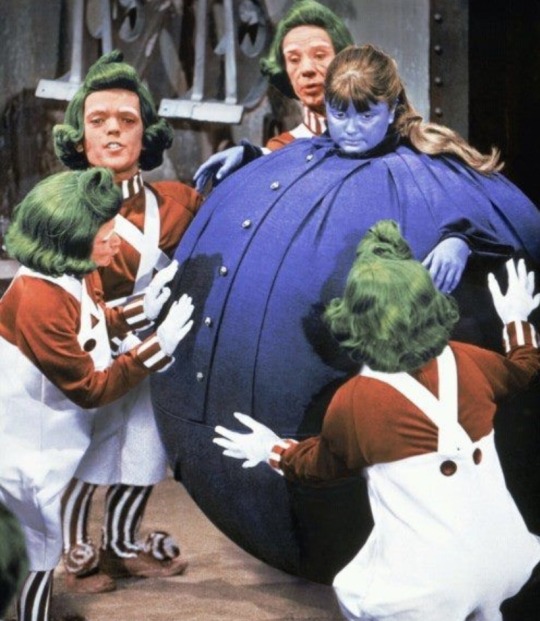

Gemini - "Pulp Fiction" (1994): A fast-paced, witty, and multi-faceted narrative with clever dialogue and unexpected twists.
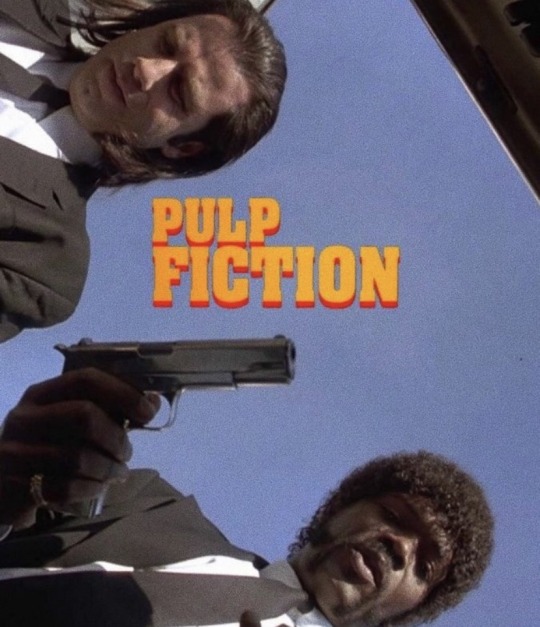
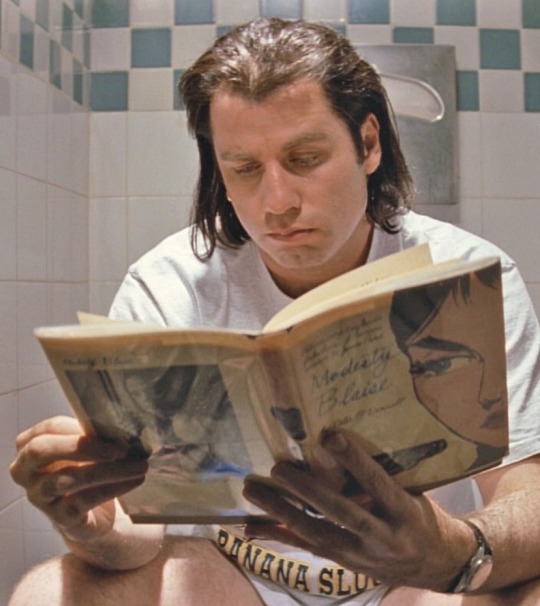
Cancer - "The Breakfast Club" (1985): An emotional exploration of the complexities of relationships and the importance of understanding and empathy.
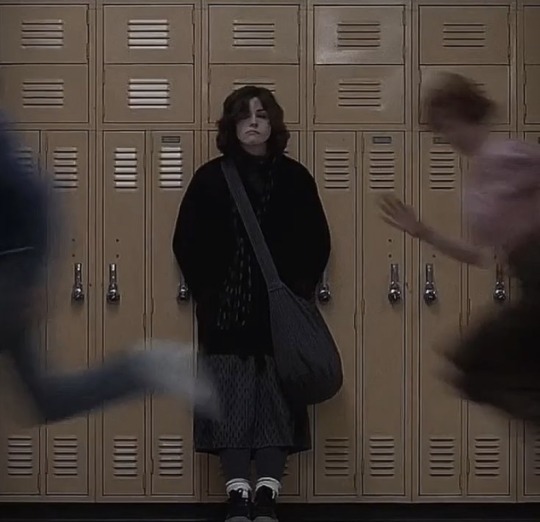

Leo - "Moulin Rouge!" (2001): A passionate, dramatic, and visually stunning tale of love, creativity, and self-expression.

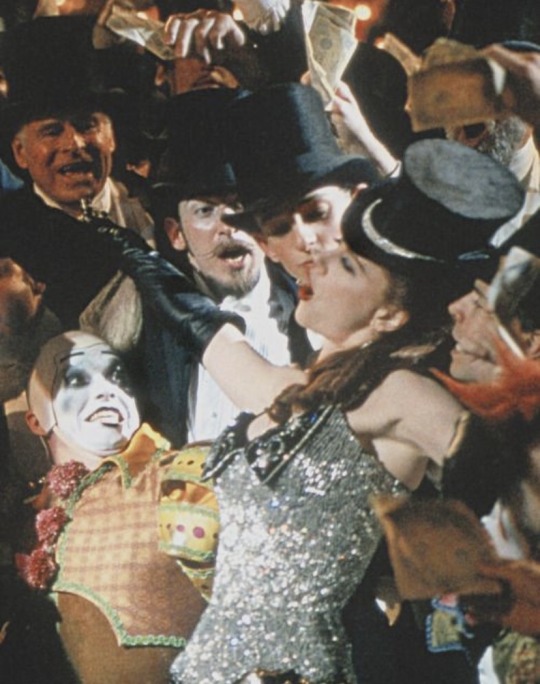
Virgo - "Inception" (2010): An intricate, layered puzzle that requires precision, analysis, and problem-solving skills to navigate.

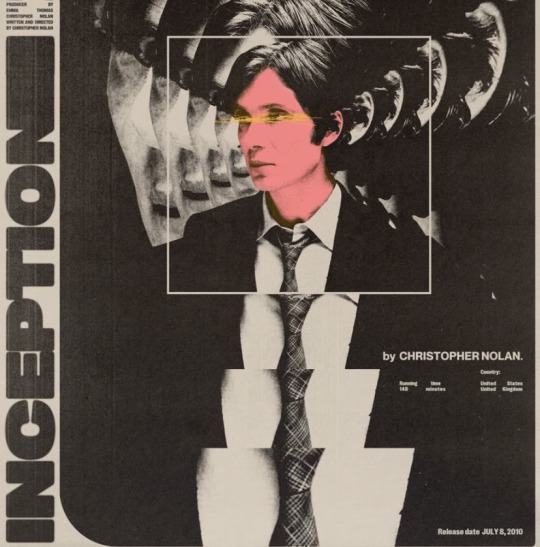
Libra - "The Royal Tenenbaums" (2001): A quirky, aesthetically pleasing story that explores the dynamics of relationships and the pursuit of harmony and balance.

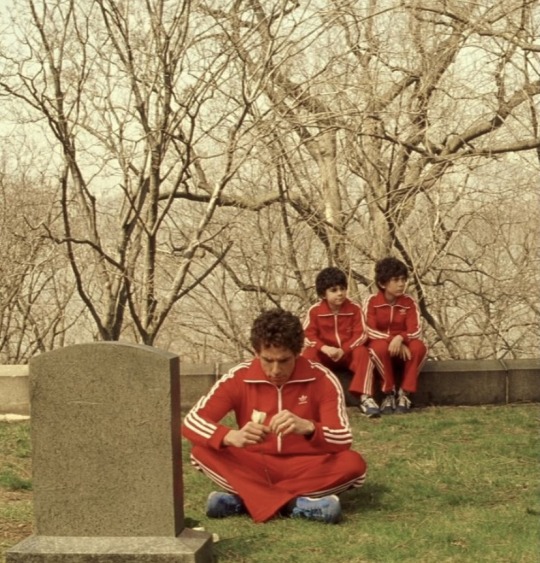
Scorpio - "Donnie Darko" (2001): A dark, mysterious, and psychologically intense journey that delves into the depths of the human psyche.
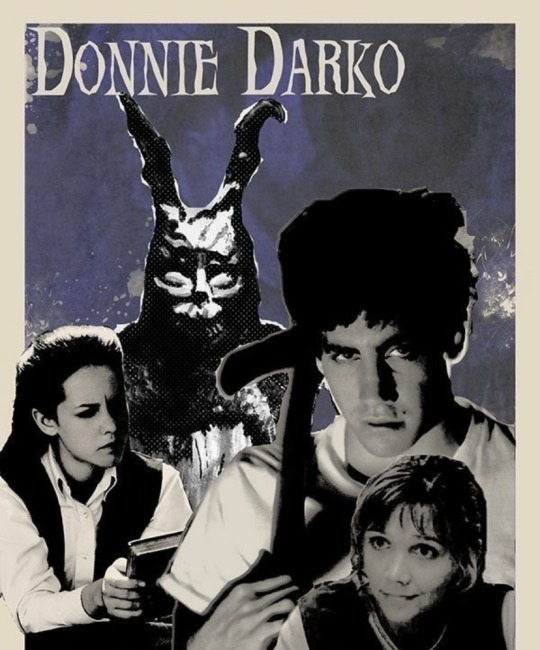
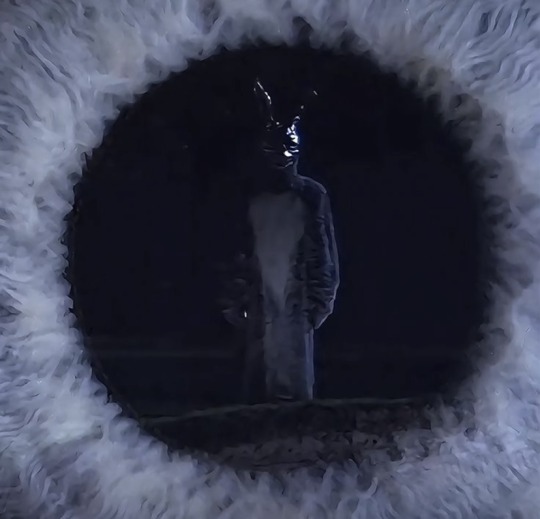
Sagittarius - "Into the Wild" (2007): An adventurous, philosophical quest for meaning, truth, and freedom beyond societal constraints.

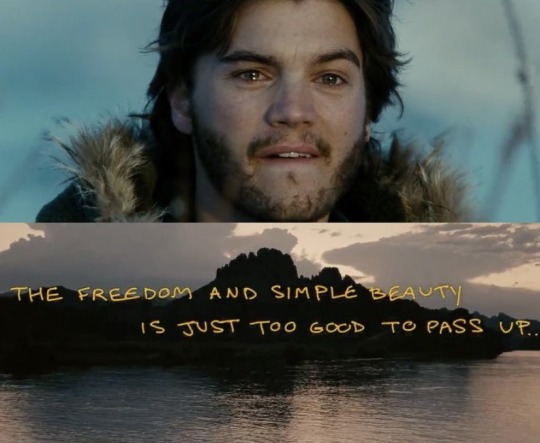
Capricorn - "The Godfather" (1972): A powerful, ambitious, and strategic narrative that explores themes of loyalty, tradition, and the pursuit of success.


Aquarius - "The Matrix" (1999): A revolutionary, mind-bending story that questions reality and champions individuality and innovation.
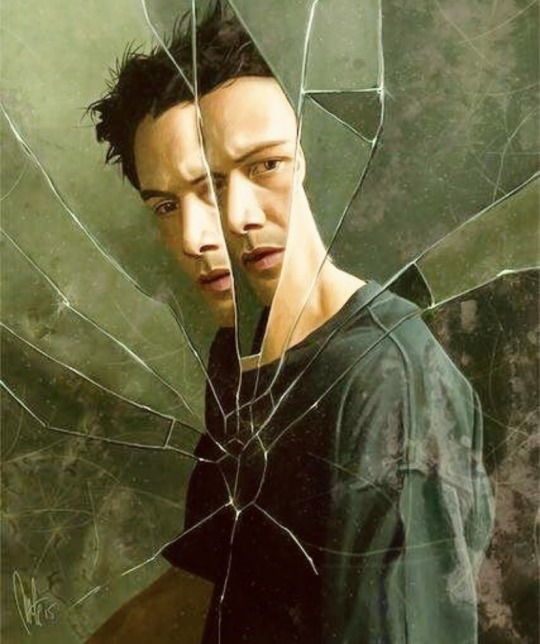

Pisces - "Eternal Sunshine of the Spotless Mind" (2004): A surreal, emotionally profound exploration of love, memories, and the blurring of fantasy and reality.


These pairings are based on the general characteristics and themes associated with each zodiac sign, and how they align with the central ideas, motifs, and tones of the respective cult classic films.
ADDITIONAL... :)
CULT CLASSIC CHARACTERS: GENDER IS INTERCHANGABLE, it's the energy.
Aries - John Bender (The Breakfast Club): Bender embodies the rebellious, independent spirit of Aries. He challenges authority figures and social norms, refusing to conform to the expectations placed upon him.
Taurus - The Dude (The Big Lebowski): The Dude's laid-back, pleasure-seeking lifestyle and his appreciation for the simple things in life align with the Taurus vibe.
Gemini - Ferris Bueller (Ferris Bueller's Day Off): Ferris's quick wit, adaptability, and ability to talk his way out of any situation are classic Gemini traits.
Cancer - Amélie Poulain (Amélie): Amélie's emotional depth, creativity, and desire to help others from behind the scenes reflect the nurturing, imaginative nature of Cancer.
Leo - Margo Channing (All About Eve): Margo's dramatic flair, confidence, and commanding presence on stage and in life embody the Leo spirit.
Virgo - Clarice Starling (The Silence of the Lambs): Clarice's intelligence, attention to detail, and dedication to her work as an FBI agent reflect Virgo's analytical and perfectionistic nature.
Libra - Cher Horowitz (Clueless): Cher's charm, social graces, and desire to create harmony and balance in her world align with the Libra archetype.
Scorpio - Lisbeth Salander (The Girl with the Dragon Tattoo): Lisbeth's intensity, mysterious aura, and ability to delve into the dark corners of the human psyche reflect the depth and power of Scorpio.
Sagittarius - Buckaroo Banzai (The Adventures of Buckaroo Banzai Across the 8th Dimension):Buckaroo Banzai is a true Renaissance man, embodying the Sagittarius traits of versatility, curiosity, and the pursuit of knowledge across multiple disciplines. He is a neurosurgeon, particle physicist, rock star, and adventurer all in one.
Capricorn - Michael Corleone (The Godfather): Michael's ambition, strategic thinking, and commitment to family and tradition align with the Capricorn archetype.
Aquarius - Neo (The Matrix): Neo's journey to question reality, break free from societal norms, and champion individuality and innovation reflects the Aquarius spirit.
Pisces - Edward Scissorhands (Edward Scissorhands): Edward's emotional sensitivity, creativity, and struggle to find his place in the world while maintaining his unique identity align with the Pisces nature.
These character-zodiac pairings are based on the dominant traits and themes associated with each sign, and how they are embodied by the respective cult classic main characters. Keep in mind that this is a subjective interpretation, and there could be various other characters that also represent each zodiac sign in their own unique ways.
#astrology#zodiac#natal chart#sagittarius#libra#astro notes#capricorn#astro observations#virgo#cult classics#cinema#film
327 notes
·
View notes
Text
So I looked back at the Fictif tag on Tumblr and… it’s just sad, honestly. I’m sad for the people that stuck around even when Nix Hydra was making stupid decisions and had controversies on them and were insulting their fans’ intelligence. I’m sad for the people that wanted to see Last Legacy be concluded, and how it’s gonna be left in Cliff Hanger Hell.
I am always a sucker for visual novels, whether I be playing them (like with The Arcana, Fictif, and Dream Daddy) or I’m just watching people play it (like Love and Deepspace), I like seeing a multiple choice game where the ending and outcome is different. I especially love it when it’s a dating simulator or otome game (kind of the same thing) because I can insert myself in a situation when I can romance a hot guy or girl.
I know there are some followers on here that followed because of me thirsting for my Fictif favorites and loving the stories… well up until Nix Hydra decided to be dumb and not give the female love interests a chance like Tess and Celia. And I was mad about what happened with Celia’s story, meanwhile I don’t even like the two other guys from the same visual novel universe. I loved her a lot and I wanted her story to be as long and engaging with two different endings, but nah, I don’t get that, but the two guys I am not even attracted to get that treatment.
Not to mention the same copy and paste corporate statement and “apology” after disappointing fans and making it crystal clear that Nix Hydra only used LGBT themes just to market their game. That’s about it. That is why whenever I see corpos use LGBT themes to market their product, I always question if it’s genuine or not. Spoiler alert, it’s not 100% genuine. Just like how Nix Hydra I was not genuine in their apology when Tess’s story in Roadkill was cut short meanwhile the other two guys Poe and Howie got more than 10 chapters.
I was there before Dorian purchased Fictif and The Arcana. It felt like an insult that Nix Hydra straight up was not listening to any of us about our concerns and criticisms about how they handled the female love interests and of course, how they are not updating Last Legacy, and the last update was back in September of 2023. SEPTEMBER 2023. Do you know how much of a longtime that is for an app that has visual novels?
Imma be real with you. Jesse Rodriguez was the first guy that did it for me in Fictif, in the Visual Novel Ghosted. Like… a man with bad boy with a heart of gold vibes and in an already established relationship with the main character and only the main character can see his ghost? Loved it.
Last Legacy is what attracted me to Fictif the most, because Sage (the catboy in the game) gave me Dante vibes before I even started playing Devil May Cry, Felix (the necromancer mage) I loved the most because I love his aesthetic, I love his personality, and I felt for him when he lost his boyfriend. Anisa I also loved a lot, and I love how adorkable she is but at the same time, makes a good leader, and I love characters who show leadership, but I feared that she would get the exact same treatment Tess and Celia got, so I left Fictif altogether.
I deleted Fictif and The Arcana and said, “screw this, I deserve better games and better stories.”
So… do I hate Fictif and The Arcana? No. I still like them, it just feels like a tough pill to swallow just seeing old stories that were properly concluded with my favorites be stomped into the ground by Nix Hydra and their bad decisions.
Plus, looking back at my old Fictif and Arcana content, and seeing where I am now, I can look at it with bittersweet memories. Hey, I can even make OCs inspired by my favorites from Fictif, because if my personal favorites are not gonna get the same treatment as the fan favorites, then I will give them that treatment.
And some people in both fandoms have also made great fanworks of Fictif and The Arcana, so I will check out more of those on A03 whenever I’m missing my favorites but don’t want to download the apps anymore.
If any of The Arcana and/or Fictif fans (former and current) are reading this, you guys deserved much better than what happened. You guys have been the most chill fandom I’ve been in even when Nix Hydra was not listening to any of us. I’m glad to have been part of both the Arcana fandom and the Fictif fandom. I mean that.
28 notes
·
View notes
Text
One day I saw a tiktok where someone was creating creatures based on the shape of random objects they would find. I thought it would be cool to try. And then, I remembered that one of my ocs comes from another universe where something happened that caused some animals, insects, plants and even objects to transmute. So, I wanted to create some design ideas of what they could look like with that technique (at least at first it was, but I ended up just making the shape up). I created only 11 design yet, but I might gonna make more at some point.
Also, I wanted to make them look like the drawings were pages of a grimoire. So, I also made up some descriptions (that, by the way, are written in the language that I also made up for that universe) and made it look kind of like old paper.
Also, I separated them in 3 categories :
1- Type A : peaceful.
2- Type B : usually peaceful, but can be dangerous sometimes.
3- Type D (there’s no "C" in that language because it’s a phonetic language) : always dangerous.
Anyway here’s those who are type A and the translation under them :
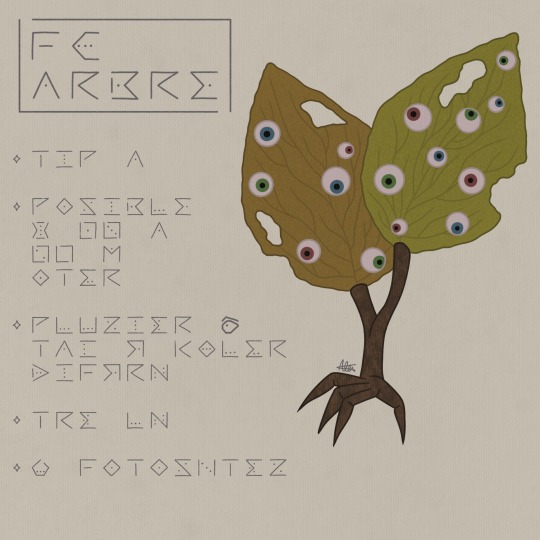
Creature 3: tree leaves
- Type A
- Can reach between 13 and 20 m high.
- Multiple eyes of different sizes snd colors
- Really slow
- Feeds from photosynthesis
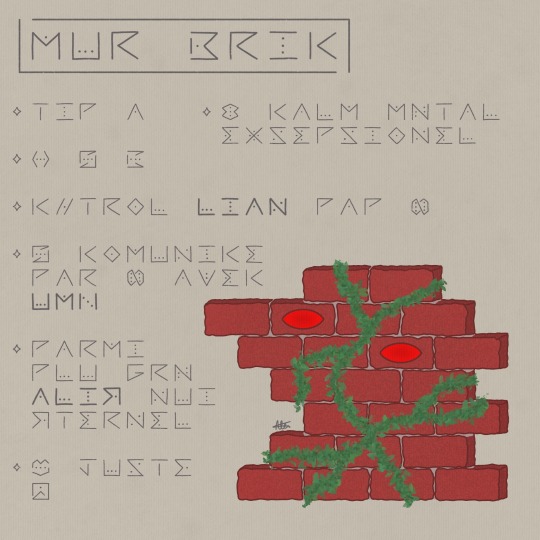
Creature 5 : Wall of bricks
- Type A
- Can’t move.
- Can controle the vines on them by telepathy.
- Can communicate with people by telepathy.
- Were one of the biggest allies of the "eternal night" ( that’s the name that I gave to the war in that universe).
- Only wants peace.
- Has an exceptional mental peace.

Creature 7 : Mout-Mout (sheep)
- Type A
- Feeds from plants.
- Has a big logical, visual and emotional intelligence.
- Social
- Lives in flock.
- Loyal
- Really patient.
- Calm
- Really curious and explorer.
- Good Memory.

Creature 8 : Kame-Lion (chameleon)
- Type A
- Lives in the high trees.
- Can fly.
- Feeds of insects and plants.
- Tendency to stress easily.
- Has the capacity to change their colors. It helps them regulate their body temperature.
#oc#my art#drawing#artists on tumblr#digital drawing#digital art#sketch#digital illustration#original character#creature#creature design#grimoire#art#artwork#original art
12 notes
·
View notes
Text
Fragments - episodes 23-26 author notes
You can find similar breakdown posts on older episodes in my pinned!
Obligatory ShB spoiler warning.
The general status quo hasn't changed since Vivi's arrival to the First: he still doesn't feel any land under his feet, Exarch still doesn't inspire trust, although there's no reason to distrust him either. Vivi isn't in a rush to meet the Scions because usually their perspectives don't help him at all. Hence he fucks around in the Crystarium instead of doing the msq.

You can hear the sound of Exarch failing the dating sim once again.
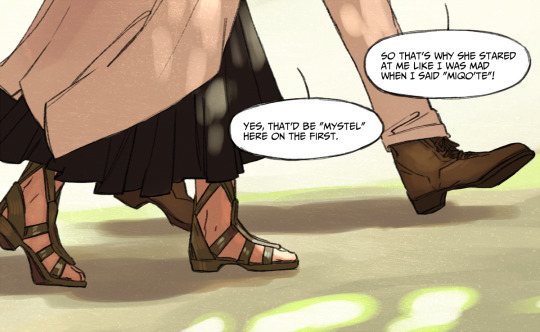
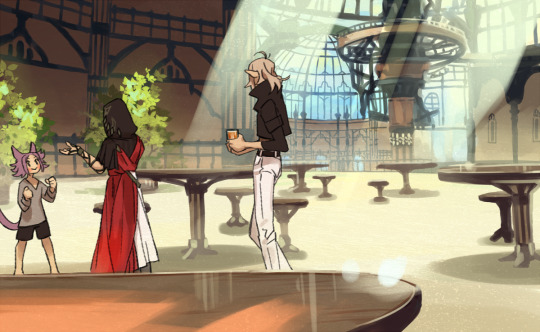
Talking about a mystel. Bumping into a mystel. They could get run over by a stampede of cats at this point and Vivi would still think this guy's probably a hume. He genuinely has No Idea. Had he had an idea, he would be actually more tactful. Maybe.
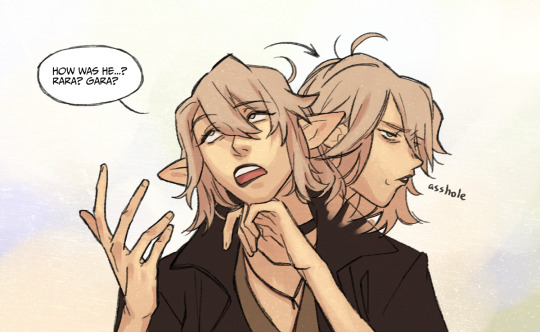
Me: no graphic violence Also me: murder onscreen
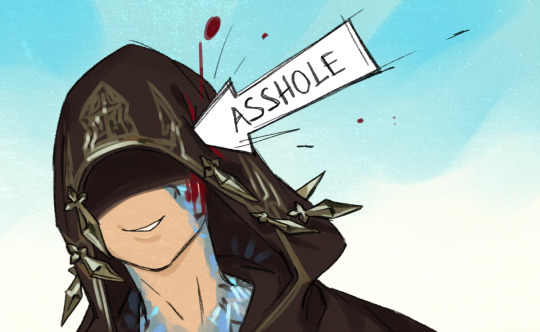
I hope the reference to episode 11 is clear, but here's a refresher: that's what ARRRaha is mostly remembered as. For multiple reasons. Mostly for magically killing himself and giving Vivi some mild stress and an even milder blow to his ego.

Exarch's fate was to choke on his coffee there and then, he kept his composure by a miracle no less. Vivi doesn't know the meaning of what he just blurted out, he simply rolls the letters in his mouth, still struggling to remember "G'raha".

HE MANAGED! The embodiment of intelligence.

Vivi reflects on the events of previous episodes and the dangers of the fae folk, and decides to do a massive handwave at that. He's walking a fine line, but he legit doesn't care.
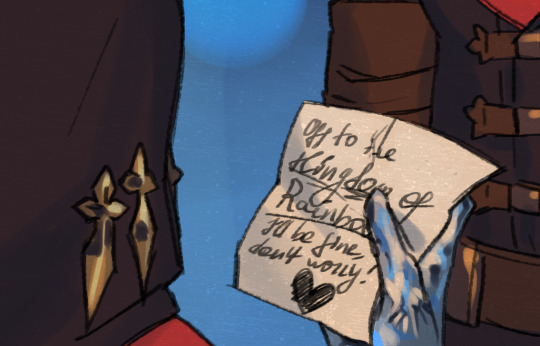
Canon emoji user 🖤
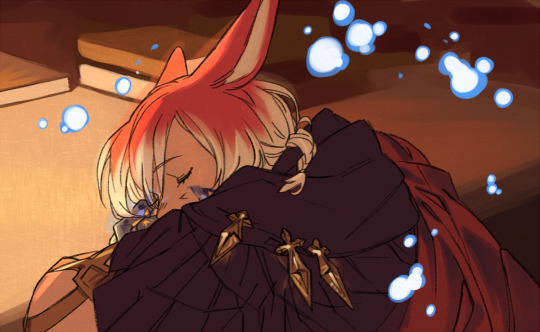
Exarch has a hate-hate relationship with sleep, however, when he feels like unwinding or resetting his mind, he turns to memories of moments when he felt safe enough to drift away.
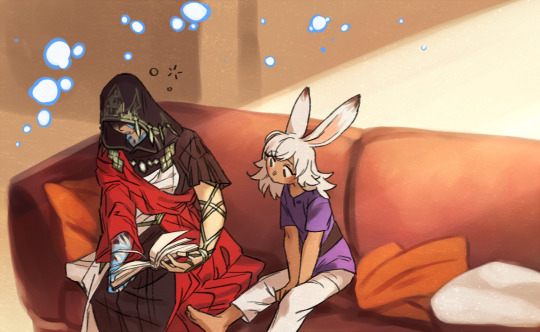
He must've felt the most warm and human when the young Lyna stayed with him all the time.
I sat on this self-contained story for a year. Officially the most wholesome episode ever. There's a bit of One Piece influence, if you remember Nami's backstory. Gen-san wore a pinwheel on his cap to appear less scary to the little Nami, and cheer her up.
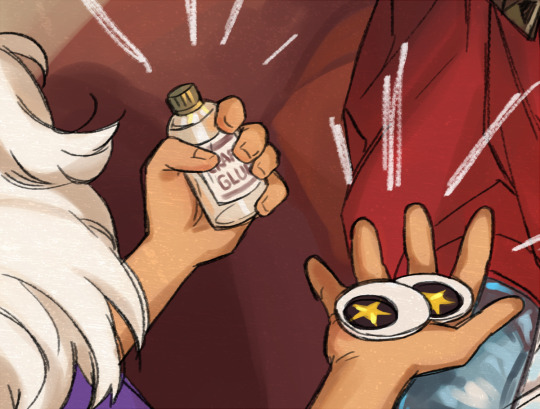
Someone read this as "crap glue", which brings me infinitely more joy than my original "craft glue" x'D
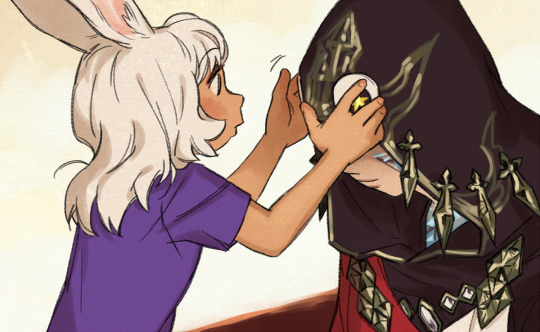
There's a super subtle smile. He knows. He probably sensed Lyna approaching him, but remained still to see where this goes.
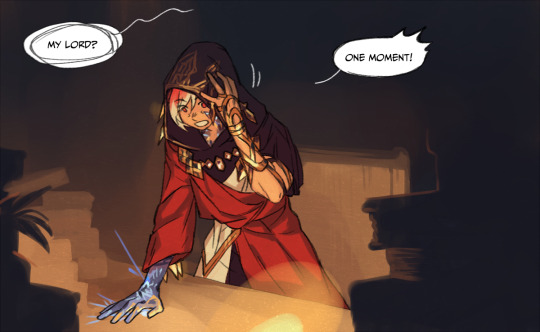
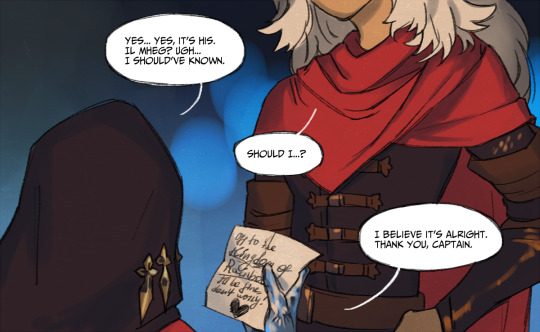
Back to the present, where they refer to each other by titles.
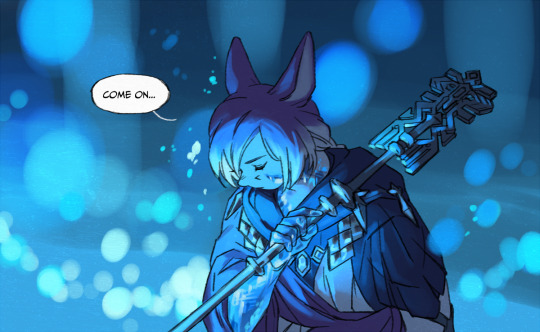
He's g'oogling.
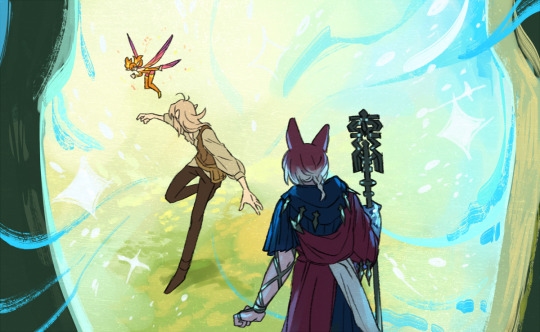
G'oogle results: 1 fae, 1 slacking idiot.
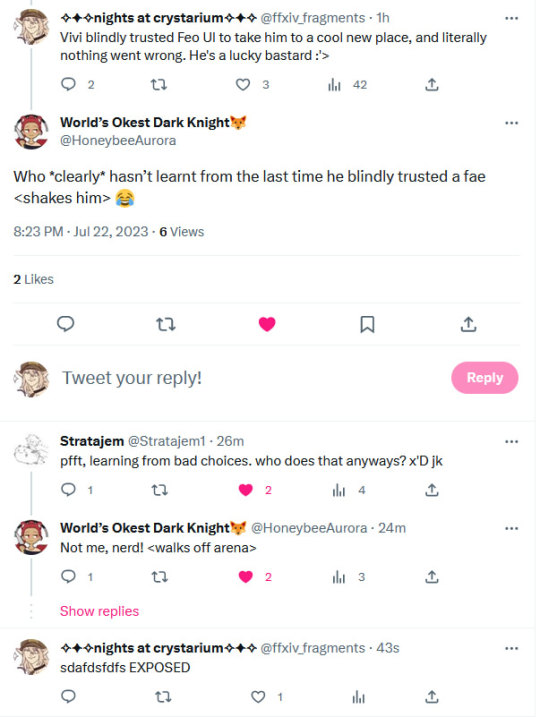
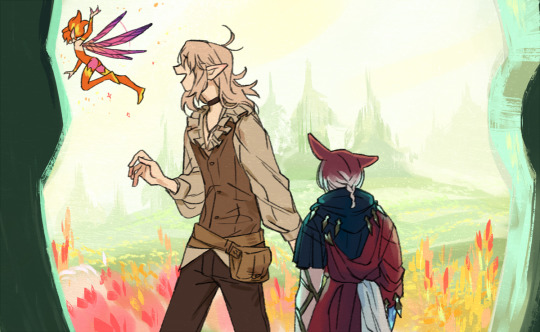
Exarch isn't just jealous or yearning, he's also kindaaaaa in the middle of his grand plan, yet his hero isn't keen of jumping into action? And he doesn't know how to confront him about that. Luckily, Urianger also happens to be in Il Mheg.
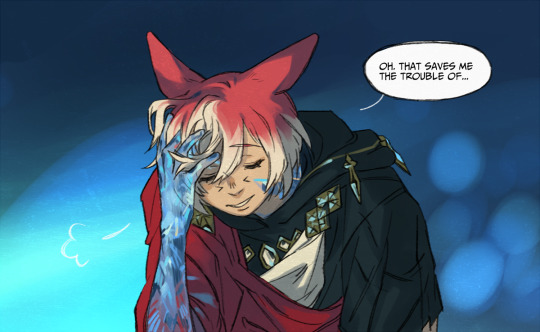
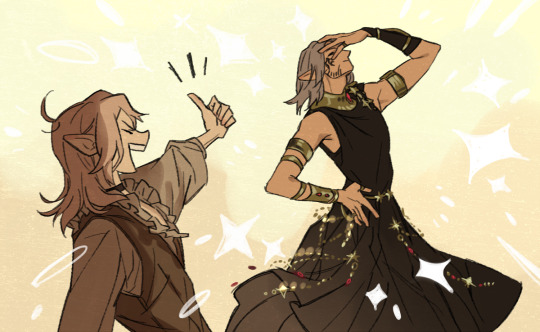
Vivi smacks a like on Urianger's outfit. Rated S for peak sluttiness.
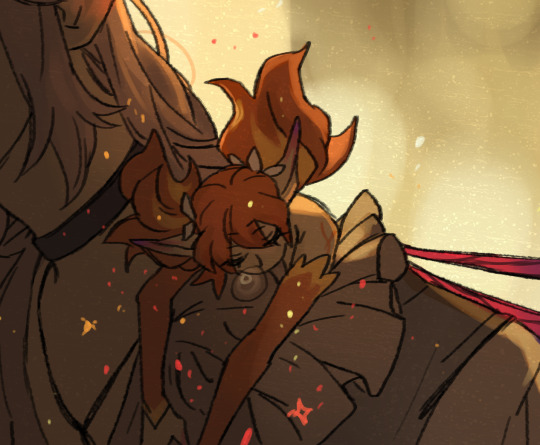
Nobody talks about Feo Ul's snot bubble so I will x'D
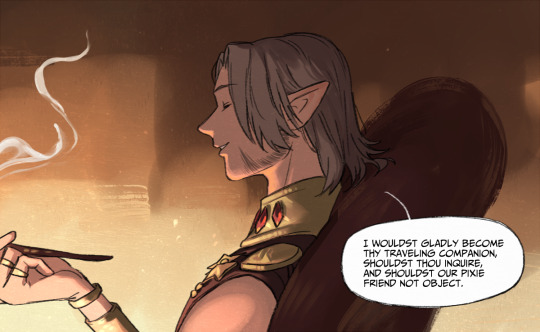
Urianger doesn't wanna leave his comfy place for an adventure, he visually demonstrates that while telling a polite lie, trusting Vivi to interpret that as intended.
They have a special vibe of quiet, maskless understanding, even if they don't interact much. They've got nothing to butt heads over. Vivi's fond of people who don't "fit in" and go against the grain. Being smart and observant as he is, Urianger knows that Vivi's rather hopeless, and doesn't waste his energy on trying to debate, direct, or, gods forbid, fix him.
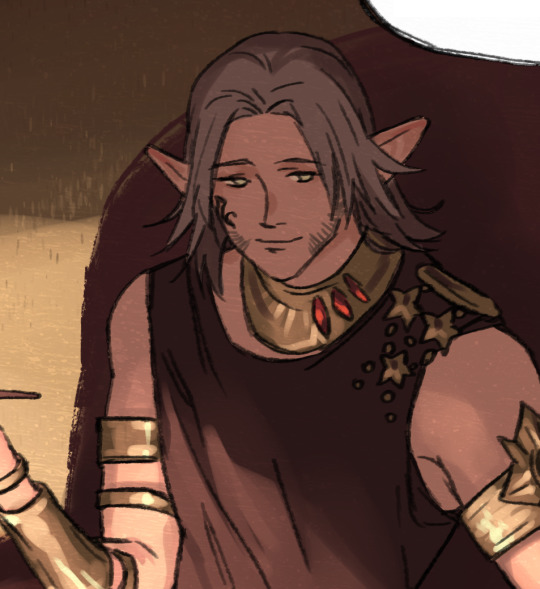
Just a closeup because he looks cute here :> To keep your expectations grounded, though: this's one of the veeeeeery few Urianger episodes. He has little overall "screentime". This comic isn't trying to be a fanservice for every character, even if I personally like them. Gotta keep things focused.

This one's kinda important: Vivi acknowledges how nice and quiet it feels (in the moment? In Il Mheg? On the First?), but the realization doesn't fully bloom in his mind yet.
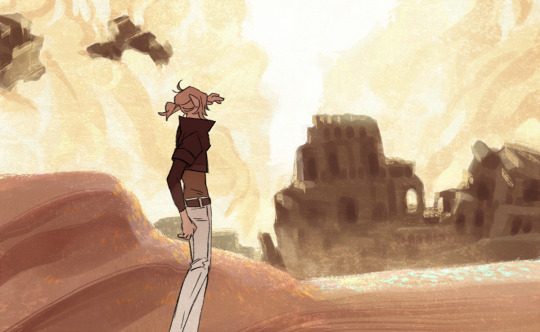
"Mmyeah there are definitely better cracks to ponder out there".
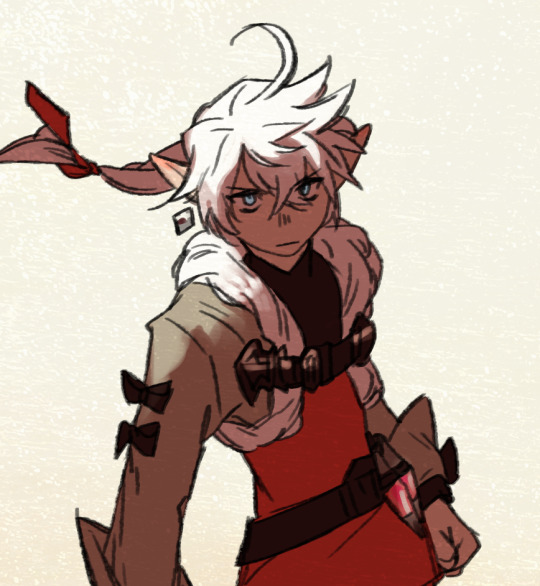
Another closeup because *clutches at heart*
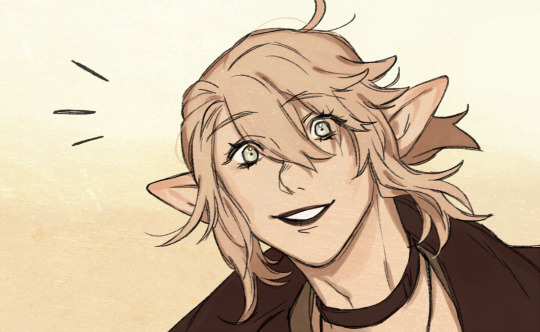

Two things: his own, genuine excitement to reunite with fren, followed by self-reminder that she's no fren and that he has to maintain distance (Vivi who are you trying to fool you're bad at this).
Also mirroring. He sees Alisaie's face and drops his own.
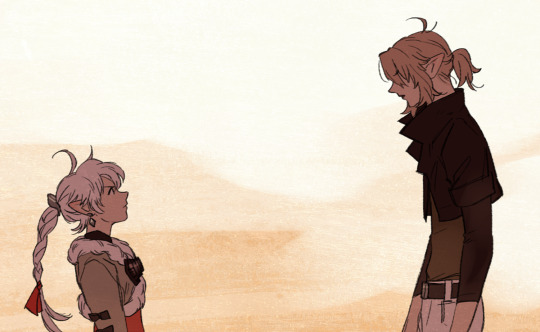
You peek inside Alisaie's brain and find a coin loudly rolling around, one side says "omg it's HIM!!!!!", the other "beat this mf up". Why? Because she can. And probably because the word of Vivi's arrival had already reached her. He spent a good week doing nothing in the Crystarium (and even Il Mheg) instead of rushing to meet her.
The new tumblr post editor (that wasn't forced on me until ~2 months ago) won't let me add anymore pics. I was thinking of making meatier but less frequent posts of this type, because they'll massively add up over time. Imagine a new reader looking at 300 episodes and 100 recaps. I'd feel overwhelmed. But I guess I'm left with no choice but to keep these recaps relatively short and frequent.
Anyway! Thanks for reading!!!!! I'm blessed to have people invested enough to interact with my work on this level.
127 notes
·
View notes
Text
LGBTQ+ Disabled Characters Showdown Round 2, Wave 3, Poll 11


A character being totally canon LGBTQ+ and disabled was not required to be in this competition. Please check qualifications and propaganda before asking why a character is included.
Check out the other polls in this wave and prior here.
Ayda Aguefort-Dimension 20
Qualifications:
Autistic queer women/phoenix💜💜
She is Sapphic and canonically on the autism spectrum.
Propaganda:
She's an awesome autistic head-librarian who also happens to be the girlfriend of one Fig Faeth (pc of Emily Axford). She's cute, super-powerful, and her dynamic with Fig is one of the best romantic storylines I know💜💜
Ayda Aguefort (pronounced EYE-da) a half-phoenix divination wizard and head librarian of the Compass Points Library in Leviathan, a vast pirate city in the Celestine Sea, made up of thousands of shipwrecks all connected together to create a floating island. She is described as a resplendent and beautiful young woman, with a striking resemblance to her deadbeat father/legendary wizard Arthur Aguefort. From the knees down she has large, almost metallic golden talons, with digitigrade ankles. Her wings are deep red, turning orange, and as they reach yellow at the ends, flicker with little flames. She is noticeably not a harpy as she has has arms as well as wings. Her arms are tattooed with many orange runes on her dark human skin. Her eyes are pupils set into roiling balls of flame. She has a short shock of fiery red hair at the top of her head. She wears white linen pants with a pirate sash, a vest, and a bandolier which holds two scrolls. She also has two small books strapped under each arm where one might have guns. Ayda has experienced multiple reincarnations due to her abilities as a half-phoenix. She has lived in Leviathan for around 150 years, but is over 300 years old. In one of Ayda's previous reincarnations, she adopted Garthy O'Brien as her child. Her current reincarnation is seventeen, with Garthy now as her guardian. Her past reincarnations have left notes for her future selves to follow, as once she's reborn, she has no memories of her past lives. She previously believed herself to be only 175 years old, and has no idea what she did for the first 125 years of her life, as one of her incarnations destroyed all her notes in an attempt to start fresh. She regretted this decades later and began writing notes again. Ayda is autistic and can be very hard to read as she often behaves in a very transactional way and uses blunt language. Her eyes being balls of fire doesn't help. She's a very intelligent and accomplished wizard, and takes pride in her work at the library, although gets lonely sometimes and is desperate for a friend. She is always looking to expand the library with new knowledge, and asks a lot of questions. Before meeting the Bad Kids, she was very lonely, and is now very excited to have so many transitive best friends, as well as a super awesome/badass punk-rock tiefling bard girlfriend.
Kim Kitsuragi-Disco Elysium
Qualifications:
Visually impaired
Propaganda:
I dunno man. He's Kim Kitsuragi. There's nothing I can say about him that hasn't already been said. He's quiet and reserved and uncomfortable with emotions. He's a self-proclaimed Torque Dork who loves his car like a child. He listens to heavy metal music. He's a centrist. He's a homosexual. He's consistently given shit by everyone around him for his race, his sexuality, and his disability, and he's taught himself to respond to it with cold professionalism. He dresses in historical communist pilot cosplay. I love him with my entire heart.
#polls#poll#disability#disabled characters#lgbtq#lgbtq characters#id in alt text#lgbtq dcs round 2#lgbtq dcs r2 wave 3#ayda aguefort#dimension 20#kim kitsuragi#disco elysium
23 notes
·
View notes
Text
Success stories & methods
Sometimes I have to remember what I manifested to keep the faith. (Imma manifest a better memory and constant confidence next.)
My apartment. Through sats even when I was anxious and stressed sometimes because I had about a week to find a place to live, I still had high standards for my apartment. I wanted bright, clean, big, center of town, 2 bathrooms, and a big shower. My price range also. Got exactly that, a listing that should have been filled months ago because it was a great location was still up and exactly the price I wanted. Technically 1 and 1/2 bath but still. I really love it, it's bright with an amazing view of the city and larger and more modern than most apartments here. Mainly did SATs and scripting for this one. I envisioned the color of the walls, floors, the bathrooms etc.
Getting my university acceptances. My first uni I didn't know about the law yet, I just toured it, loved it, and had an unshakeable confidence and the "feeling" of knowing I would get in. Despite multiple people telling me it would be hard and the acceptance rate is low. One thing I have always been blessed in is intelligence/education, so this came naturally to me. I guess you could say I embodied the state of knowing for this one.
For my current master's degree, there was a long process of applying and waiting for different things to be approved. Same with the apartment, I scripted, visualized/sats about getting my acceptance in my email or on a screen.
Vacation to a city with my 3 friends. This one is kind of funny because I mainly manifested this when i was annoyed by one of my old roommates. Like if we were both in the kitchen and she was making noise I would just repeat to myself "I'm not here, I'm in x city with my three friends..." You could say this is the "you are already in Barbados" technique. I also visualized photos that we would take there together. And in the end I didn't pay for much bc they booked the airbnb earlier (I offered and they said no LOL)
Sleeping over with my SP twice. First time was just a feeling. Sometimes I just get in easy moods that feel, idk, warm? And I just know that whoever I'm with will offer to do what I want. In this case we were on a date and he offered for me to stay over. The second time, I intentionally used SATs for a while after a bit of no contact and he randomly reached out, some circumstances/bridge of events played out and I ended up sleeping over again.
New SP driving me home. Similar to the above we were hanging out and I was in a good mood so I just thought he'll drive me home (even though he didn't have to) And he offered like 2 minutes later.
New SP kissing me. This is an interesting one. A few weeks ago I was fed up because of a circumstance. It seemed like he didn't want the same thing that I did and I'm someone who is sensitive to rejection so it bothered me, I even lost sleep and cried a lot. But the next day even though I felt like shit I kept on my manifesting grind, listened to music about men obsessed/happily in love with their girls, music that boosted my confidence too. I rampaged (written) and listened to a lot of loass content.
Then 3 days later we were going to hang out (in a group). Before I left my house I just said/decided "What if he kisses me today." Had no freaking clue how or why that would even happen but something clicked. I made my decision, put it out there and just continued on with my day, half not even believing it would happen. It just felt good to do in the moment. It felt like I knew my power and I used it. We had a good time and as we were saying goodbye, I hugged him and he kissed my temple. He'd never done that before and I'd never see him do it to anyone else, but it felt so natural in the moment. And after that he offered me his jacket to go on a walk... super cute.
The power of making a decision and having confidence in it seems to be a thread here. For some things, since I already believe in the power of sats, I can do that while being anxious and it still works. But not everything needs that much focused attention. Sometimes you can just declare it in your head and relax.
I'm still figuring out why sometimes it feels so easy, when I get in those warm relaxed confident moods, but other times not. Hopefully I can be in that mood all the time.
8 notes
·
View notes
Text
Interesting Papers for Week 13, 2024
The self and the Bayesian brain: Testing probabilistic models of body ownership through a self-localization task. Bertoni, T., Mastria, G., Akulenko, N., Perrin, H., Zbinden, B., Bassolino, M., & Serino, A. (2023). Cortex, 167, 247–272.
A whole-task brain model of associative recognition that accounts for human behavior and neuroimaging data. Borst, J. P., Aubin, S., & Stewart, T. C. (2023). PLOS Computational Biology, 19(9), e1011427.
Inhibitory tagging in the superior colliculus during visual search. Conroy, C., Nanjappa, R., & McPeek, R. M. (2023). Journal of Neurophysiology, 130(4), 824–837.
Hippocampal representation during collective spatial behaviour in bats. Forli, A., & Yartsev, M. M. (2023). Nature, 621(7980), 796–803.
Emergence of belief-like representations through reinforcement learning. Hennig, J. A., Romero Pinto, S. A., Yamaguchi, T., Linderman, S. W., Uchida, N., & Gershman, S. J. (2023). PLOS Computational Biology, 19(9), e1011067.
Error-independent effect of sensory uncertainty on motor learning when both feedforward and feedback control processes are engaged. Hewitson, C. L., Kaplan, D. M., & Crossley, M. J. (2023). PLOS Computational Biology, 19(9), e1010526.
Multiple memory systems for efficient temporal order memory. Jafarpour, A., Lin, J. J., Knight, R. T., & Buffalo, E. A. (2023). Hippocampus, 33(10), 1154–1157.
How awareness of each other’s mental load affects dialogue. Knutsen, D., & Brunellière, A. (2023). Journal of Experimental Psychology: Learning, Memory, and Cognition, 49(10), 1662–1682.
Developmental trajectory of time perception from childhood to adolescence. Li, Y., Gu, J., Zhao, K., & Fu, X. (2023). Current Psychology, 42(28), 24112–24122.
A multi-layer mean-field model of the cerebellum embedding microstructure and population-specific dynamics. Lorenzi, R. M., Geminiani, A., Zerlaut, Y., De Grazia, M., Destexhe, A., Gandini Wheeler-Kingshott, C. A. M., … D’Angelo, E. (2023). PLOS Computational Biology, 19(9), e1011434.
The inhibitory control of traveling waves in cortical networks. Palkar, G., Wu, J., & Ermentrout, B. (2023). PLOS Computational Biology, 19(9), e1010697.
Inferring local structure from pairwise correlations. Rahman, M., & Nemenman, I. (2023). Physical Review E, 108(3), 034410.
Beyond ℓ1 sparse coding in V1. Rentzeperis, I., Calatroni, L., Perrinet, L. U., & Prandi, D. (2023). PLOS Computational Biology, 19(9), e1011459.
Linguistic law-like compression strategies emerge to maximize coding efficiency in marmoset vocal communication. Risueno-Segovia, C., Dohmen, D., Gultekin, Y. B., Pomberger, T., & Hage, S. R. (2023). Proceedings of the Royal Society B: Biological Sciences, 290(2007).
Mnemonic discrimination deficits in multidimensional schizotypy. Sahakyan, L., Wahlheim, C. N., & Kwapil, T. R. (2023). Hippocampus, 33(10), 1139–1153.
An imbalance of excitation and inhibition in the multisensory cortex impairs the temporal acuity of audiovisual processing and perception. Schormans, A. L., & Allman, B. L. (2023). Cerebral Cortex, 33(18), 9937–9953.
Spike-timing dependent plasticity partially compensates for neural delays in a multi-layered network of motion-sensitive neurons. Sexton, C. M., Burkitt, A. N., & Hogendoorn, H. (2023). PLOS Computational Biology, 19(9), e1011457.
Development of human hippocampal subfield microstructure and relation to associative inference. Vinci-Booher, S., Schlichting, M. L., Preston, A. R., & Pestilli, F. (2023). Cerebral Cortex, 33(18), 10207–10220.
Task-dependent optimal representations for cerebellar learning. Xie, M., Muscinelli, S. P., Decker Harris, K., & Litwin-Kumar, A. (2023). eLife, 12, e82914.
Dissecting the chain of information processing and its interplay with neurochemicals and fluid intelligence across development. Zacharopoulos, G., Sella, F., Emir, U., & Cohen Kadosh, R. (2023). eLife, 12, e84086.
#neuroscience#science#research#brain science#scientific publications#cognitive science#neurobiology#cognition#psychophysics#neurons#neural computation#neural networks#computational neuroscience
20 notes
·
View notes
Text
At the heart of writer-director Elena Oxman’s stunning feature debut Outerlands is a richly nuanced and captivating central performance by Asia Kate Dillon. It is an affectingly understated, delicate film and Dillon, with their beautifully expressive face and underlying emotional intensity, proves to be a perfect fit for Oxman’s style. As the film opens we meet Cass (Dillon) as they juggle multiple jobs—working as a nanny for a wealthy family, serving at an upscale restaurant with demanding clientele, and dabbling in party drug dealing—in order to pay for their rent-stabilized studio apartment, squirreling away cash under their bed. Meanwhile, their landlord is attempting to intimidate them with a constant flurry of notices about changes in policy. Their tiny apartment—the kind of place, like the rest of the film’s locations, that looks like where a real person actually lives, not a movie set—is where they spend most of their evenings alone drinking beer. It is situated in the Outer Sunset region of San Francisco, west of Golden Gate Park, what used to be referred to as the Outlerands.
The imprint of a changed, hyper-gentrified city following the influx of tech companies, is felt in the fibre of the film, both narratively and visually, as the steely glass skyscrapers loom over San Francisco’s more characterful, vibrantly colourful architecture. While in a city that was once the epicentre of the country’s queer community, all that seems to be on offer now in Cass’ neighbourhood is a weekly “queer night” at a local straight bar, that comes with a $20 cover charge. When it comes to immersing us in the city, Lucia Zavarcikova’s cinematography is hypnotic, especially paired with Lena Raine’s stirring, frequently choral, score. With dynamic movement that suggests Cass’ perspective as they are riding around on their scooter, the strong sense of place that is rendered put me in mind of Bay Area filmmaker Jenni Olson’s urban landscape 16mm films. Oxman and Zavarcikova invite the audience in, letting us get intimate with the characters, while the screenplay never overstates anything, including Cass’ gender identity and sexuality. During a flirtatious laundromat encounter with Kalli (Louisa Krause), their rather enigmatic co-worker at the restaurant whom they have a crush on, Kalli jokingly compares Cass to “Mary Poppins” because of their work as a nanny. “More like Peter Pan”, Cass comes back with. Later at the bank, when Cass is trying to conform with their landlord’s new payment procedures, their banker, Denise (Lea DeLaria), comments on the funds that have gone towards medical bills. We also catch a glimpse of some testosterone in Cass’ bathroom cabinet. As a viewer, it is refreshing to be treated with intelligence by a filmmaker, trusting us to pick up on these details, and in turn helping to make the film all the more absorbing.
After Kalli and Cass spend the night together, conveyed in a gorgeously sensual and steamy scene sex (inspired by Bound) that is all about the connection between the characters, Kalli calls to ask if Cass will take care of her twelve-year-old daughter, Ari (Ridley Asha Batemen), while she is out of town for a couple of days. Cass agrees, but as days pass by, Kalli remains completely out of contact and it becomes uncertain whether she is ever coming back to the city. Suddenly confronted with having to care for someone else, a poignant bond gradually builds between Ari and Cass, one that brings memories of Cass’ own difficult childhood, left in the care of their grandmother, bubbling to the surface. Having dug out an old box of childhood belongings, Cass becomes drawn back into playing a computer game they played when they were younger, Outerlands, centred on an isolated astronaut trying to find their way home, that echoes Cass’ state of mind then and now. The subtlety of Dillon’s brooding performance makes even the quietest moments of the film compelling, as the lifetime of hurt and struggle that is visible on their face, gives way to flickers of healing breaking through. Batemen is a revelation as Ari, bringing a restrained, natural quality to her performance and proving an engaging scene partner with Dillon, including one heartbreaking sequence when Ari finally allows her guard to drop and to let Cass in. The work between the two is tender and vulnerable, while it reveals so much about who these characters are, often without a word being spoken.
The excellent cast includes a lively and endearing supporting turn from Daniel K. Isaac as Cass’ outgoing restaurant co-worker Emile, who is determined to form a deeper connection with them. While Lea DeLaria is an utter delight as Denise. As a performer, her presence immediately calls forth a sense of queer screen history over the past few decades, while she fully embodies her character, bringing a warmth and reassuring vibe, despite the harsh, cold environment of her bank office. As well as delivering some levity, DeLaria’s character has a full backstory, and offers a sense of extended queer chosen family in a city where that is fast disappearing. Having world premiered at SXSW in March, Outerlands has gone on to play a number of major LGBTQ+ and mainstream festivals internationally, winning audience awards at Wicked Queer in Boston and Turin’s Lovers Film Festival. It is satisfying to see this exquisitely-crafted, character-driven queer indie be deservedly celebrated. It is a gently profound film that makes a deeply moving, indelible impression.
2 notes
·
View notes
Note
please tell me about I Was a Teenage Exocolonist, if you feel so inclined? i don't know much about it but your posts about it have been making me very curious! (direct references to Murderbot you say?)
Oh, I would LOVE to ramble about I Was A Teenage Colonist! 🥰 I'm on lunch at work, but otherwise I would break out PowerPoint and do a proper propaganda post because IWATXC fully deserves one. (*Correction: I was on lunch at work when I started writing this. I wrote way too much and had to finish when I got home, which should probably tell you what you're getting into. My deepest apologies.)
So, it's like 50% visual novel and 50% video game. The story is what really matters, but how that story goes is entirely dependent on your choices. There are 29 (I think) different endings you can uncover (I've only gotten 4 so far), multiple different characters you can romance if you're into that, and tons of different areas (e.g. skill levels, friendship points, etc.) that you can focus your energy on to unlock new pieces of story content about various characters.
As far as the video game component goes, it's a deck builder where the memories your player character collects become your deck of cards to use in challenges. However, if you don't want to bother with that, there's a setting that will let you turn off card challenges altogether.
BUT here's the actual juicy stuff:
So, the story opens with you as a 10 year-old kid on a colony ship that's landing on your new home planet. The ship has been traveling for 20 years, so you were born in space.
The colonists left Earth to escape the capitalist hellscape it's become, and they're all a bunch of hippies, so the Preservation vibes are very strong! It feels a little like how the founding of Preservation was described in the MB books.
Once you've landed, however, you run into some big problems. 1) All of the ship's hydroponics were destroyed because it was a rough entry. 2) Some of the planet's wildlife is NOT friendly (as Murderbot would say, something's always trying to eat the humans). 3) Some of the planet's seasons are hazardous in a variety of unpleasant ways. 4) There are signs that this planet had intelligent life once. And that it might still...👀
Once you're there, it's all hands on deck to survive! You're a kid, so you do need to finish your education, but you balance that with working in various parts of the colony and deciding what role you want to take on as your main career. You can become a farmer like the player character's parents, you can become a scientist and hang out with the colony's AI (who has some things in common with ART), you can join the survey teams (like PresAux my beloved!) and go out to explore and document the planet...the options are endless!
Now, the problem with landing on a semi-hostile planet is that the odds are high that the colony is going to lose people. And you do. A lot of people, if you aren't careful. Some of the deaths are pretty heart-wrenching.
BUT
There's something special about your player character. Ever since landing on the planet, they've had...dreams. Strange gut feelings. Knowledge that they shouldn't have. Premonitions about things that are going to happen, about people they're going to meet... Sometimes, it isn't enough to matter, but the more playthroughs you do, the more your character knows because they do gradually become aware that they're in a time loop of sorts. This gives them more options and better odds for saving the people they love, whether that's in the form of having clues about how to stop the colony's famine or knowing where you need to be to save the governor from being killed by hostile fauna! The game runs from age 10 until age 20, so you have ten years to save your colony and sort out your life.
My personal favorite things:
So many things are extremely customizable, especially in terms of preferred pronouns, gender presentation, dating (or not dating at all---choosing not to won't deprive you of anything in-game) preferences, etc.
The little in-jokes (including the direct Murderbot reference!)
The art style is GORGEOUS! It's so warm and inviting and beautiful. And for big moments, you get these extra detailed full-screen scene cards that show up to point out that you're reached a milestone.
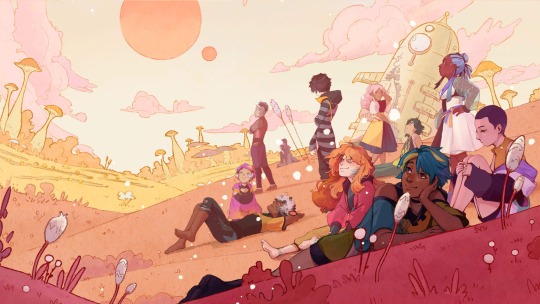
There are no real-time time limits/constraints, so it's easy to play without getting stressed.
The characters! There's such a broad variety, but they're so lovable (except for Vace---I can't STAND Vace). I'm especially fond of Cal and of the player character's dad (who reminds me of Ratthi in some ways).
The time-loop elements are handled so, so well. They add such a fascinating twist to the story while also fixing the replayability issue that so many games have. It gives you an incentive to start playthrough after playthrough just to get more information about that element of the PC's story!
All in all, it's my favorite game of the ones I've played this year, and a solid second-favorite of all time, right after Stardew Valley. Especially since I feel like I've barely scratched the surface of the game's content, even after four playthroughs! For anyone who enjoys gaming at all and happens to be a fan of Murderbot, of solarpunk as a concept, or of sci-fi in general, this game is a joy to play!
If you do end up giving it a shot, you know my inbox/DMs are always open if you want to come yell about it with me! Thank you for asking and for giving me a reason to infodump about it! ❤
#i was a teenage exocolonist#video games#iwatxc#or is it iwatec?#i haven't seen consistent tag abreviations for this game and i'm not sure who to ask#personal#i'm so sorry for how long this ran#it got away from me a lil bit
12 notes
·
View notes
Text
MediaTek Kompanio Ultra 910 for best Chromebook Performance

MediaTek Ultra 910
Maximising Chromebook Performance with Agentic AI
The MediaTek Kompanio Ultra redefines Chromebook Plus laptops with all-day battery life and the greatest Chromebooks ever. By automating procedures, optimising workflows, and allowing efficient, secure, and customised computing, agentic AI redefines on-device intelligence.
MediaTek Kompanio Ultra delivers unrivalled performance whether you're multitasking, generating content, playing raytraced games and streaming, or enjoying immersive entertainment.
Features of MediaTek Kompanio Ultra
An industry-leading all-big core architecture delivers flagship Chromebooks unmatched performance.
Arm Cortex-X925 with 3.62 GHz max.
Eight-core Cortex-X925, X4, and A720 processors
Single-threaded Arm Chromebooks with the best performance
Highest Power Efficiency
Large on-chip caches boost performance and power efficiency by storing more data near the CPU.
The fastest Chromebook memory: The powerful CPU, GPU, and NPU get more data rapidly with LPDDR5X-8533 memory support.
ChromeOS UX: We optimised speed to respond fast to switching applications during a virtual conference, following social media feeds, and making milliseconds count in in-game battle. Nowhere is better for you.
Because of its strong collaboration with Arm, MediaTek can provide the latest architectural developments to foreign markets first, and the MediaTek Kompanio Ultra processor delivers the latest Armv9.2 CPU advantage.
MediaTek's latest Armv9.2 architecture provides power efficiency, security, and faster computing.
Best in Class Power Efficiency: The Kompanio Ultra combines the 2nd generation TSMC 3nm technology with large on-chip caches and MediaTek's industry-leading power management to deliver better performance per milliwatt. The spectacular experiences of top Chromebooks are enhanced.
Best Lightweight and Thin Designs: MediaTek's brand partners can easily construct lightweight, thin, fanless, silent, and cool designs.
Leading NPU Performance: MediaTek's 8th-generation NPU gives the Kompanio Ultra an edge in industry-standard AI and generative AI benchmarks.
Prepared for AI agents
Superior on-device photo and video production
Maximum 50 TOPS AI results
ETHZ v6 leadership, Gen-AI models
CPU/GPU tasks are offloaded via NPU, speeding processing and saving energy.
Next-gen Generative AI technologies: MediaTek's investments in AI technologies and ecosystems ensure that Chromebooks running the MediaTek Kompanio Ultra provide the latest apps, services, and experiences.
Extended content support
Better LLM speculative speed help
Complete SLM+LLM AI model support
Assistance in several modes
11-core graphics processing unit: Arm's 5th-generation G925 GPU, used by the powerful 11-core graphics engine, improves traditional and raytraced graphics performance while using less power, producing better visual effects, and maintaining peak gameplay speeds longer.
The G925 GPU matches desktop PC-grade raytracing with increased opacity micromaps (OMM) to increase scene depths with subtle layering effects.
OMM-supported games' benefits:
Reduced geometry rendering
Visual enhancements without increasing model complexity
Natural-looking feathers, hair, and plants
4K Displays & Dedicated Audio: Multiple displays focus attention and streamline procedures, increasing efficiency. Task-specific displays simplify multitasking and reduce clutter. With support for up to three 4K monitors (internal and external), professionals have huge screen space for difficult tasks, while gamers and content makers have extra windows for chat, streaming, and real-time interactions.
DP MST supports two 4K external screens.
Custom processing optimises power use and improves audio quality. Low-power standby detects wake-up keywords, improving voice assistant response. This performance-energy efficiency balance improves smart device battery life, audio quality, and functionality.
Hi-Fi Audio DSP for low-power standby and sound effects
Support for up to Wi-Fi 7 and Bluetooth 6.0 provides extreme wireless speeds and signal range for the most efficient anyplace computing.
Wi-Fi 7 can reach 7.3Gbps.
Two-engine Bluetooth 6.0
#technology#technews#govindhtech#news#technologynews#processors#MediaTek Kompanio Ultra#Agentic AI#Chromebooks#MediaTek#MediaTek Kompanio#Kompanio Ultra#MediaTek Kompanio Ultra 910
2 notes
·
View notes
Text
Exploring Philosophy through Doctor Who
⃪ Welcome! 🍄 . ⵢ
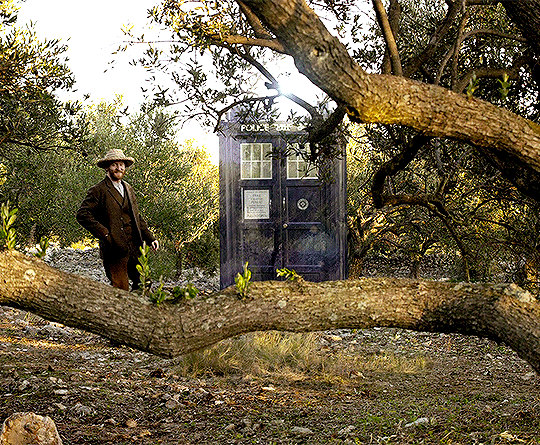
"Doctor Who" is an iconic science fiction series that portrays the adventures of an eccentric protagonist who has the ability to change appearance whenever he's on the brink of death. He belongs to the Time Lords, a species from another planet. The series has a somewhat retro visual style with a strong British influence, especially in its humor. The Doctor always invites companions on his travels, which quickly turn into dangerous adventures. Together, they face frightening alien creatures and challenging situations. Broadcast by the BBC since 1963, the series remains relevant over the years due to its ability to reinvent itself, whether through new actors or innovative storylines. Currently, the role of the Doctor is played by actor Ncuti Gatwa, the first Black and openly gay actor to take on the role of the Doctor.

Now, speaking about philosophy, the philosopher Aristotle has a lot in common with "Doctor Who." Both have their followers, or companions, who help them in their journeys, and they face adversaries that threaten order and justice. Aristotle believed in a world governed by natural and rational laws, while "Doctor Who" explores multiple realities where the rules of the universe can change. Aristotle advocated for ethics based on virtue and happiness, while the Doctor follows a more flexible moral code that values the preservation of life and friendship above all else.
The series addresses philosophical concepts such as metaphysics. The TARDIS, the Doctor's iconic ship, is an example of an object that defies the laws of physics. It is bigger on the inside than on the outside and travels through time and space by manipulating the energy of the time vortex. This all fits into the idea of dimensional transcendence, where the internal space of the TARDIS exists in a distinct dimension from the external one. The TARDIS, beyond being a machine, possesses a certain personality of its own, and these elements make it an interesting link to Aristotelian metaphysics.
Another central philosophical theme is identity and memory. With each regeneration, the Doctor changes appearance, style, and even aspects of his personality but retains fundamental traits like his intelligence and sense of justice. This leads us to reflect on how the character deals with his own transformations and the changes in relationships with his companions and enemies. The Doctor's identity is constantly questioned by the characters around him, as he never reveals his true name and is known only as "The Doctor."
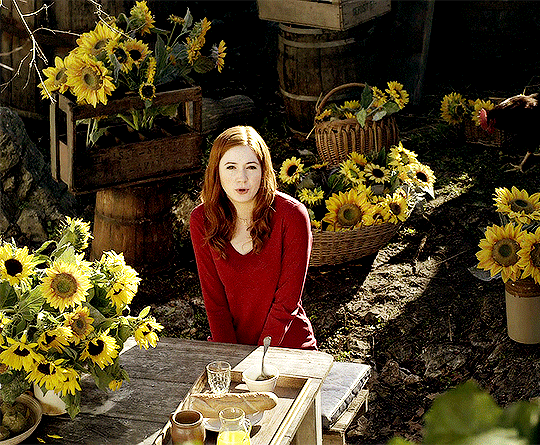
"Doctor Who" also explores the nature of time in a unique way. Time is treated as a dimension that can be manipulated but also has its rules, such as fixed points that cannot be altered and alternate timelines. These rules help avoid paradoxes and preserve the integrity of the web of time, a concept the Doctor explains as "wibbly wobbly timey wimey stuff."
Ethics and morality are constantly tested in the series, with the Doctor frequently facing dilemmas involving saving lives, combating threats to the universe, or deciding between right and wrong. His enemies, like the Daleks, Cybermen, and the Master, have complex motivations and often see themselves as saviors or superior, challenging the Doctor to confront not just their actions but also the principles that drive them.
Death is a recurring theme, where the Doctor's regeneration offers a form of temporary immortality, contrasting with the mortality of his companions. The series deals with cloning, consciousness transfer, and immortality, questioning the value and consequences of living forever.
Beyond these themes, "Doctor Who" addresses aesthetics, consciousness, politics, and justice, always bringing deep reflections in a fun and accessible way. Throughout its seasons, the series not only entertains but also prompts viewers to reflect on universal philosophical questions.

Finishing! 🍄 = . ༅.
In the end, "Doctor Who" is much more than a sci-fi series full of adventures through time and space. It is a true dive into philosophical themes that make us think about who we are, what is right or wrong, and even how time works. With the Doctor and his companions, we realize that life is full of questions without easy answers, but that's part of the journey.
The cool thing about "Doctor Who" is that even after so long on air, the series continues to reinvent and surprise itself, showing that change can be positive and necessary. With its unique style and humor, it reminds us that no matter the challenge, what really matters is valuing life, friendships, and never losing curiosity.
So, whether facing Daleks, traveling in a TARDIS that’s bigger on the inside than on the outside, or breaking all the rules of time, "Doctor Who" teaches us that the important thing is to keep exploring and adapting. In the end, what truly matters is what we learn along the way and how we use it to make the universe a slightly better place.
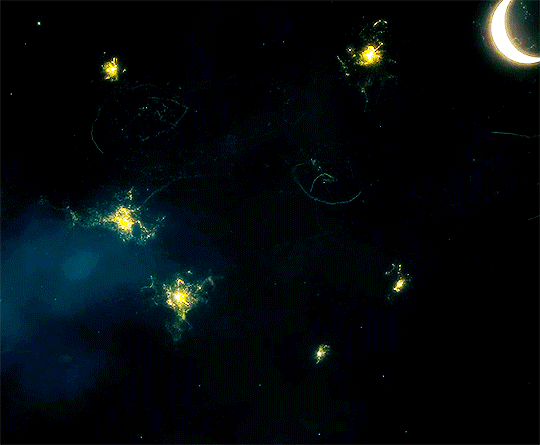
5 notes
·
View notes
Text
Code of Ethics - Chapter 4 - Scrambled Eggs

I'm not super happy with this one, it's short, and until part 5 rolls around (around 84k words away...presuming I don't have to add chapters, which I almost always do) this will seem like a pointless little diversion into the MC's life.
Preview below the cut:
Dylan had finally managed to get the hangover symptoms under control enough to stagger to the kitchen to make breakfast. Drinking nearly a gallon of water while making the greasiest possible omelet he had the ingredients for, he managed to dull the pain to a dull roar.
Finally turning on the news after his intentional 24 hour personal news blackout, he was somewhat relieved that, this year at least, they hadn’t hammered the patriotic drumbeat of the memorial to stretch it into a second day. The relief was short lived as the news cycle was instead dominated by a story that would fill nearly everyone watching with dread.
“We’ve received new video of the action occurring in Austria. A warning to viewers with sensitive stomachs, this footage can be quite brutal in places.” Dylan’s already nauseous stomach clenched, not from the visuals, but from the reminder that the world was a powder-keg and people all around the world were banging their steel hammers on the powder in hopes of finding the flint the hard way. As an analyst for the agency, he’d seen plenty of intel that some governments thought classified but the American intelligence community were still damn good at getting their hands on. As an agent he’d been privy to briefings that even the Joint Chiefs didn’t have knowledge of. The imagery was just another day in the life for him.
But the knowledge that some dumb outsiders were going to start World War 4 when America hadn’t even managed to knock down the walls from World War 3? And America being 50-100 years behind in tech? Low on manpower? The public face of the government didn’t like to let it slip, but the agency and all the TLAs and the officer corps of the military all knew that America was going to get flattened if they couldn’t get the country’s collective ass in gear and actually commit to the build-up needed to take the country’s place as the world’s only superpower back.
He shook his head as he took another bite and almost snorted it up his nose when he heard the reason for the fighting, “…talks over water rights broke down to the degree that a nuclear weapon…”
Water rights. Multiple thousands, maybe millions killed over water rights.
He turned the stream off. Nukes…America knew nukes. From being the first country to use them during wartime to being on the receiving end of the last wartime use…until Austria, that is.
---
Read the rest at Scribblehub
#original fiction#fiction writing#fiction#science fiction#sci fi#are we the baddies?#transgender#trans author#queer author#lgbtqia+#lgbtq+#lgbt#lgbtq#trans#trans woman#troubleverse#quietvalerie#trouble with horns#code of ethics
3 notes
·
View notes
Note
Do you think a faithful adaptation of ASOIAF (in an ideal world where the books are finished) would work if they included narration? Especially if the overall aesthetic vision would be more inspired by John Boorman's work/80s fairytale films? I keep thinking about this and like. How robbed we were of a good adaptation. There's some aspects in the show that really worked (mainly most of the cast and like. A few individual shots) but from the very beginning they just didn't do a good job and made almost everything worse. I keep thinking about like an ideal way to adapt the books (I don't think it's impossible!) and the main thing that would be important for me would be to try to make it as faithful as possible, possibly only add scenes that are important for the relationships (I.e. scenes between Catelyn and the girls, since GRRM himself regrets not giving them more) and give it a more coherent aesthetic vision/really lean into the fantastical/focus more on the starks than on the lannisters and targs.
Back to the narration: with Sansa especially I just cant see it working without narration. She figures out so much and has so much background knowledge that i really don't think can be included in dialogue (especially since Littlefinger tells her to never even speak out things to herself since everyone is spying) and good narration could really help
Sidenote but I find it so annoying how GOT just used any opportunity to make Sansa dumber (show!petyr telling her everyone else is smarter than her vs book!petyr acknowledging her intellect, "I'm a slow learner but I do learn", having podrick instruct her etc)
I'm not sure! It might work? A big challenge with narration would be the fact that GRRM is working with individual POV's and multiple unreliable narrators and you'd have a hard time making the presence of deep personal bias felt without being Very Obvious about it and spoiling it as a technique of obfuscation.
I also think the language is often extremely beautiful and underrated in the books, but you can't necessarily make that center-stage in a visual medium, you'd have to translate the imagery into images that evoke the same feelings. Otherwise, it's more of an audiobook with visual aids.
I still think animation would be a great way to tell the story because it's much easier to distort "reality" to signal the presence of memories, extreme emotions, historical information, dreams, magic, hypotheses and concepts.
One thing that would probably be important in any medium would be to slow down and let characters observe from time to time. Just the acknowledgement that they are watching and having thoughts about something, highlighting what they actually focus on, would already work well to establish the importance of their internal life and their individual intelligence and a potential direction of their thoughts.
But I am no expert in these matters.
4 notes
·
View notes
Text











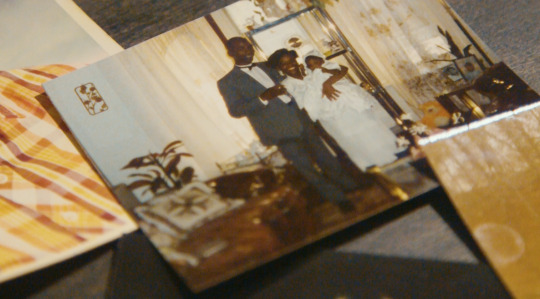










(Installation photo credit: Hai Zhang)
Exhibition | Ah New Riddim: A Marked (Black) Axiological Shift at Cuchifritos Gallery + Project Space
Can the axiologies and stories oscillating at the margins mark the discourse of Western logic positioned at the center, and how might this marking register in visual representations of the urban?
Ah New Riddim (2023) is the third and final iteration of the multimedia series Constructs and Context Relativity (2019-2023) by interdisciplinary artist Christie Neptune. The installation and interactive documentary examines the spatial-temporal relationship of memory and place embedded within the implosion of dancehall culture in East Flatbush. The film utilizes 80’s dancehall archival footage, the quiet of black subjectivity, and concentric interactive storytelling to expound the relationship between black globality and dancehall in the American urban. In a pivot around her embodied experience as a black Caribbean American, Neptune considers the potential of black popular culture in marking space.
In Ah New Riddim, concentric storytelling registers a cacophony of black perspectives. Neptune’s subjective experience in the American urban and the migration stories of community members in East Flatbush pivot around dancehall home video of Neptune’s father. Research, writing, and art produced from this series work to frame an artistic intelligence around Marked Axiological Shifts, a concept introduced by Neptune in a recent essay that defines a new language in visual culture grounded in African world-making cosmologies.
Marked Axiological Shifts are nonlinear and interactive artistic approaches that register a perpetual reimagining of black futures across space and time. It marks the decorum of modern cinema and visual culture with the conventions of African temporality to foster multiple planes of perspectives and fields of movement within concentric forward moving narratives mapped across moving images, sculpture, performance art, and print. In this exhibition, six channels of video interface with scaffolded speakers made of mirror, LED monitors, and wood. The speakers, a re-articulation of the Caribbean Sound System tradition, add further nuance to the filmic encounter in space. As material, screen, haptic surface, and sculptural unit, the sound system transmits information that doubles the spectator’s spatial perception. Upon contact, the spectator experiences temporal disjuncture caused by the collapse of their point of view, embodied form, and projected media upon the unit’s reflective surface. The gesture fosters multiple fields of viewing within a single expressive form, an element integral to African frameworks of temporality.
Ah New Riddim demonstrates the potential of black popular culture within representational practices that speaks across both dominant and marginal spatialities. This new framework of understanding considers the agency of marked axiological shifts within discursive urban space, an intervention that superimposes a wide aperture of black subjectivity(s) upon the narrow plane of the American urban.
This exhibition draws from Christie Neptune’s research paper “Ah New Riddim: A Marked (Black) Axiological Shift Across Space and Time” [READ HERE]
August 04, 2023 to September 16, 2023 Cuchifritos Gallery and Project Space Inside Essex Market, 88 Essex St #21, New York, NY 10002
Exhibition Link: https://www.artistsallianceinc.org/exhibitions/
Thank you to every supporter who contributed to make this exhibition happen:
Foundation of Contemporary Art, MIT Council of the Arts, MIT Art, Culture, and Technology program, Artist Alliance Inc., Cecile Chong, Emily B. Yang, Tariku Shiferaw, Larry Cook, Ayesha Charles, Jenna Charles, Terence Washington, David Freedman, Claire Watson, Mike Tan, Jodi Waynberg, Micaela Martegani, Jeff Swinton, Carl Hazelwood, Aisha White, Milk Spawn, Cari Sarel, Vivian Chui, Paul So, Camilo Alvarez, Kelsey Scott, Mike Brown, Darla Migan and Mary Lee Hodgens.
3 notes
·
View notes
Text
I’m glad you’re so comfortable with and proud of your religion that you feel the need to aggressively defend it while at the same time desperately trying to distance yourself from it. very cool. 👍
this is actually the exact attitude I was talking about— you ignore facts that don’t reaffirm your preexisting worldview and only seek out new information that reinforces your already held beliefs.
But, you’re right. Your actual material religious convictions do not matter. The only relevance your religion has in this context that it reveals much about your core values and the way you think about and approach the world. Which, you know, I feel is relevant considering you’re sharing an opinion that’s shaped by those values, but I digress.
You know I don’t disagree that IQ tests are inaccurate, right? That’s literally not what the original post is even about.
By interpreting the post to mean “IQ is not an accurate measure of intelligence”, you are giving IQ tests more legitimacy than they deserve by assuming intelligence is even something you can measure, let alone compare.
The original post is calling into question the validity of “intelligence” itself as a construct, not merely critiquing the methods of measurement.
And even if it WERE a post critiquing the methods of measurement—namely, IQ tests— your “critiques” do not make any sense. You are so out of your depth that you literally don’t even understand what you are saying.
There are many many many many many many many many criticisms that have been made basically since the tests were created which has led to multiple revisions that the history section of Wikipedia does a great job summarizing. This has led to the creation of many different intelligence tests which each have their own applications, limitations, and biases.
The materials I linked above primarily discuss the data collected with the Wechsler Adult Intelligence Scale, Fifth Edition (WAIS-V) or the Wechsler Intelligence Scale for Children, Fifth Edition (WISC-V), which are the most valid and reliable measures of intelligence that we currently have. The use of WAIS/WISC 5 to assess intelligence is standard in the field.
Each version of this measure that is developed takes into account criticisms, clinician feedback, and societal changes to make adjustments to the test that eliminate methodological issues which improves the validity of the measure by correcting for things like cultural biases, reliability biases, and the gradual increase in scores overtime, otherwise known as the Flynn Effect, among others of course.
Now, all of this is predicated on the belief that every human has a preset level of something we call “intelligence” that is inherent, immutable, and objectively measurable. The way each test goes about defining “intelligence” so that it can be measured is a little different. For WAIS-5, your overall score (IQ) is derived from the scores in five areas. This excerpt from “Understanding IQ Test Scores” by Marcia Eckerd from a site with resources to support people with developmental disabilities and their families provides a good overview:
The five Index Scales (which are averaged together to provide the Full-Scale IQ score) measure the following abilities:
Verbal Reasoning: Knowledge of words and being able to apply them – verbal concept formation, reasoning, and expression
Visual Spatial: Seeing visual details, understanding spatial relationships and construction ability, understanding the relationship between parts and a whole, and integrating visual and motor skills
Fluid Reasoning: Seeing the meaningful relationship among visual objects and applying that knowledge using the concept
Working Memory: Demonstrating attention, concentration, holding information in mind and being able to work with information held in mind; this includes one visual and one auditory subtest
Processing Speed: Speed and accuracy of visual scanning and identifying visual objects, short-term memory, and visual-motor coordination
Each of these scales represents an ability vital to academic performance.
As Eckerd goes on to say, “Each of these scales represents an ability vital to academic performance.” Herein lies the crux of the issue: the skills that we have decided make up the trait of “intelligence” are those that allow individuals to succeed in our society.
In American society, success is defined as the attainment of capital, which is made possible through exploitation. Therefore, skills that make you better at attaining capital through exploitation will be rewarded with ‘success’. To find out who is the most likely to succeed, we test for ability in these skills, and so on.
The “accuracy”, as you say, of this measure depends on whether you accept the premise (i.e., these five skills are correlated with success in society) at all.
You are no doubt familiar with the tale of the monkey and the fish. If not, here is a link to the story. If you’d like to read my interpretation, you can find it at the very end under the cut, but I won’t force you to read my shitty creative writing.
This parable illustrates the point that you are clumsily trying to make: intelligence tests only test how good you are at taking intelligence tests; and, there are other things that you can be good at that are not considered “intelligence” for the purpose of these tests. Common examples are people with artistic, musical, or physical abilities.
This understanding still accepts the implicit premise that intelligence can be measured i objectively, but it’s “just not being measured in the right way” or “just not measuring the right things” or “just not being measured by the right people” and so on.
This post rejects the premise entirely, instead suggesting that there exists no possible way to “objectively” or “accurately” measure intelligence.
In addition to misinterpreting the original post, you’ve said a lot of stuff about IQ tests that is just literally factually untrue. As I said above, the most commonly used IQ tests have 10 exercises that test 5 different categories of cognitive abilities.
You mention restrictive time limits— the only scores based on time are the ones that test “processing speed”. It should be self evident why a test intended to see how fast you can process information is timed, but just in case it’s not, let me explain further.
On IQ tests, the results for each exercise fall into different bands. The test administrators already know what scores are considered “normal” and are concerned with comparing your ability to this standard rather than having you complete every single exercise.
This means that, for example, if the highest scoring range (people with the fastest processing speed) is “30 seconds or less”, it doesn’t matter if you finished it in 22 seconds or 25 seconds, you would both get the same score.
It is the same on the other end. If the lowest band (the people with the slowest processing speed) is “2 minutes or more”, it doesn’t matter if it took you 2 minutes and 1 second or 5 minutes, you’re still scored the same.
Practically, this means the test administrator will set a timer for the lowest score and have you stop the activity if you have not yet completed it when the time has elapsed. They could theoretically let you continue until you finished it, but the score would be the same and you’re only going to end up compromising the results of further tests because the patient is now more fatigued from expending unnecessary effort.
There are not any other timed sections. There may be outside factors e.g., appointment time, but these are not part of the IQ assessment and are not factored into the score. Humans aren’t perfect, so I’m sure there are times where things are inappropriately factored into the assessment, but this is not the intent of the measure.
You keep saying that IQ tests “aren’t based in logic” which is also factually untrue. Most of the exercises rely on logic; for example, this is the type of logic puzzle you might see in the “visual spacial” or “fluid reasoning” sections:

There are also coding sections that are a different type of logic puzzle:
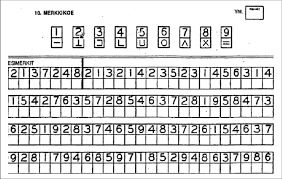
You also frequently refer to “nuanced questions”— I could not figure out what you meant by this at all until I remembered that you said you were Autistic/ADHD.
To an autistic person, some of the questions used to assess “verbal ability” may indeed seem nuanced or complex. For example, these are common questions asked in the verbal ability section:
“How many wings does a bird have?”
“What is an advantage of keeping money in the bank?”
“Why is copper used in electrical wire?”
“What should you do if someone forgets their book at the restaurant?”
I think it is worth nothing here that these exercises are intended to be clear and straightforward to an “average” or “neurotypical” person. Part of the process for diagnosing autism is administering an IQ test to determine whether the patient’s scores on these measures differ significantly from the average because deficits in verbal ability scores compared to their peers is an indication of autism. These deficits are present in these sub scores, even compared to their peers with ADHD.
If you have AuDHD, your perception of these questions as “nuanced” or “unclear” is not the universal truth, but an indication that the assessment is working exactly how it was designed to. Theoretically, someone who is “less intelligent” than a person with autism could have a higher IQ because of this disparity, which serves to further illustrate the problem with viewing IQ testing as an objective measurement of an immutable trait.
I would also like to note that it is literally not possible to “fail” an IQ test. The only thing an IQ test tells you is how you compare to every other person who’s taken the IQ test. At absolutely worst, a poor score only indicates that you scored less than everyone else who has ever taken the test. With 7 billion people on earth and rising, the proportion of people who have taken an IQ test is very small compared to those who haven’t. So even if you believe 100% that IQ is an objective, valid, and reliable measure of intelligence, it is still relative.
As for my qualifications, I don’t make a habit of sharing my private medical information with strangers online, but if you don’t want to take the word of the other published scientists I’ve linked here seriously, Im happy to share that I actually graduated suma cum laude with a bachelors of science in psychology, emphasis in research (and posted about it on tumblr) after graduating with honors from an associate of arts in psychology (which I also posted about on tumblr).
I am by no means an expert or professional, but I do have a solid grasp of the basics and certainly a better grasp than you.
The Parable of the Fish and the Monkey
By tfiosprinkles
There once was a monkey who lived in the jungle near the beach. Day after day, he would climb to the top of a palm tree overhanging the water to speak with a fish.
“Why,” said the monkey, “are you so lazy? You do not climb the trees to gather fruit to feed your family, nor do you swing from vine to vine to play with your friends. You simply rest there in the water all day, floating along. Don’t you have any sense?”
“But,” replied the fish, “I do gather fruit for my family, but the fruit lies far beyond the tree— farther than you could ever swim!”
The fish continued, “and I do play with my friends, we dart swiftly and sharply between the reaching fronds of the kelp forest, chasing one after another.”
“Bah,” cried the monkey, “you cannot pull the will over my eyes. For I know the truth! You and all your kind are stupid and senseless for you cannot climb nearly as high as me.”
The fish protested sharply, “you would not say such cruel things if you could only see what my people are really like! It is you who are stupid and senseless for you cannot swim even half as long as the smallest of all my kind!”
At this, both animals stormed off in a huff, eager to prove once and for all who was really stupid and senseless. Perhaps then they could go back to being friends, with each in their proper place.
The next day, the fish is shocked to see the massive form of an elephant striding out of the forest into the shallows of the ocean. Perched upon his back sat the monkey.
“See here,” the monkey called loudly, “I have brought with me an impartial judge to settle this matter once and for all.”
“How can that be fair?” interjected the fish “when you both walk upon the land?”
“Ahh,” smirked the monkey, “it is fair because, while he walks upon the land, he can breathe from the water.”
The monkey glanced towards the elephant who stepped into the surf, dipping his great nose into the shallows and beginning to breathe.
The fish looked on in awe before rushing away. The elephant had given him an idea.
Before long, the fish returned with a friend in tow.
“If this contest is to be truly fair,” said the fish, evenly, “it only makes sense to have two judges: one who walks upon the land and breathes water and one who lives with us in the water yet breathes air.”
At this, the dolphin leapt out of the water behind the fish, spraying air from her blowhole before sucking in a deep, salty breath.
The monkey, of course, agreed.
“Look on now,” said the monkey to the elephant, swinging from treetop to treetop “see how easily I can climb this tree? And swing from vine to vine? That fish cannot even walk upon the land much less climb!”
The monkey stared triumphantly as the fish motioned for the dolphin the surface.
“Ahh but see, I have no need to walk upon land as everything I need, the sea provides. Yet you cannot swim so much as a stroke! How do you hide from danger? How do you expect to be safe?”
The monkey cried out, “what use would I have for swimming! Predators cannot climb the trees any more than you can!”
Suddenly, the elephant spoke, stopping the animals in their tracks, “I must say, the monkey is clearly the winner, for the contest is clearly meant to measure how high one can climb! For that is who succeeds.”
“You are wrong!” squeaked the dolphin. The monkey was so surprised he fell of his branch and into the ocean. Panicked, he thrashed about until the elephant grabbed him with his trunk and pulled him back to shore.
Once the monkey was safely settled atop the elephant once more, the dolphin continued.
“the truest measure of one’s potential is how far they can travel and you can’t travel very far at all! Why, you could not even travel back to shore without help. You would never survive in the ocean.”
The animals continued to bicker on and on, never realizing that each was the best in their own way.
Isn't it fucking insane that so many people think that IQs are real. Like people genuinely believe you are born with one set level of intelligence that can be measured on a scale from 1 to ~200. As if intelligence wasn't extremely nuanced and completely subjective. And the fact that the majority of scientists that have advocated for IQ tests in the past have been eugenicists doesn't seem to concern anyone either
#let’s all try learning facts instead of just saying whatever#I know trumps influence is strong but I believe in you
25K notes
·
View notes
Text
The Role of Digital Twins in Autonomous IT Management
The IT world is rapidly shifting toward automation and intelligent systems, with a growing emphasis on autonomous infrastructure management. At the heart of this evolution is a powerful and often underappreciated technology: Digital Twins. These virtual models of physical systems are enabling the next wave of self-managing, self-healing, and self-optimizing IT environments.
By simulating real-world systems in real time and continuously learning from data, Digital Twins are becoming the nerve center for autonomous IT. They integrate with AI, machine learning, and analytics to detect anomalies, predict failures, optimize performance, and even execute corrective actions — all with minimal human intervention.

What Autonomous IT Management Really Means
Autonomous IT management goes beyond automation. While traditional automation relies on predefined rules and scripts, autonomous systems learn, adapt, and make decisions in real time. The goal is to reduce human oversight while increasing system efficiency, reliability, and responsiveness.
In this context, Digital Twins play the crucial role of contextual intelligence providers. They gather, process, and visualize data from multiple sources, creating a unified layer of insight that powers real-time decision-making.
Digital Twins as the Foundation for AIOps
Artificial Intelligence for IT Operations (AIOps) is transforming the way businesses manage complex infrastructure. But AIOps can’t function in a vacuum — it requires a continuous stream of clean, contextualized data. That’s where Digital Twins come in.
By mirroring the entire IT environment — from data centers to cloud workloads — Digital Twins serve as the sensory system for AIOps platforms. They provide structured, real-time data enriched with operational context, enabling AI algorithms to identify patterns, anomalies, and root causes more accurately.
This seamless integration of AIOps with Digital twins leads to faster incident detection, automated remediation, and more intelligent decision-making.
Real-Time Incident Management and Resolution
One of the most compelling use cases of Digital Twins in autonomous IT is real-time incident management. Traditional IT monitoring systems rely on alerts and thresholds, which often result in false positives or delayed responses.
With Digital Twins, IT teams can create live simulations of infrastructure behavior. When a system anomaly is detected, the twin replicates it virtually, tests possible solutions, and recommends the most effective response — or even initiates automated fixes.
For example, if a storage node is underperforming, the Digital Twin can simulate data redistribution across the cluster, measure its impact, and execute the optimal action autonomously. This drastically reduces mean time to resolution (MTTR) and keeps systems stable without human input.
Self-Optimizing Workload Management
Modern IT environments are dynamic, with workloads moving across virtual machines, containers, and cloud platforms. Keeping these workloads optimized manually is a constant challenge. Digital Twins bring intelligence to this process.
By monitoring resource usage, latency, and application demand, Digital Twins predict the best possible workload distribution. They simulate changes and provide feedback loops to AI engines, which then execute adjustments in CPU allocation, memory usage, network bandwidth, and more.
This leads to self-optimizing systems that dynamically adapt to changing workloads, user demand, and operational constraints — boosting efficiency and performance across the board.
Predictive Failure Prevention and Auto-Healing
Preventing failures before they happen is a core pillar of autonomous IT, and Digital Twins make this possible. They collect and analyze data continuously, identifying subtle patterns that indicate potential problems — such as disk degradation, memory leaks, or network congestion.
Once a threat is detected, the twin can simulate corrective actions and automatically trigger preventive maintenance. In more advanced setups, Digital Twins initiate self-healing protocols, such as restarting services, reallocating resources, or isolating faulty components without human involvement.
This predictive and self-healing capability not only minimizes downtime but also increases system resilience and user satisfaction.
Adaptive Security and Threat Response
Cybersecurity threats are becoming more sophisticated, and static defense mechanisms can no longer keep up. Digital Twins enhance autonomous IT security by continuously modeling the behavior of users, applications, and networks.
When deviations from normal behavior are detected, the twin assesses the potential impact and tests response strategies virtually. This allows organizations to implement adaptive security policies that evolve with emerging threats.
For instance, if suspicious login attempts are observed in a particular region, the Digital Twin can simulate a geo-restriction or implement multi-factor authentication enforcement. These actions can be automated in real time, reducing response time from hours to seconds.
Enabling Digital Governance and Policy Automation
IT policies are vital for security, compliance, and performance — but managing them manually is labor-intensive and error-prone. Digital Twins provide a platform to simulate and enforce policies automatically.
They monitor infrastructure behavior and compare it against established policies. If violations are detected, the system can alert administrators or automatically correct configurations to realign with governance standards.
This is especially powerful in multi-cloud environments where security rules, resource quotas, and compliance frameworks vary. With Digital Twins, digital policy enforcement becomes autonomous, consistent, and scalable.
Integration with Robotic Process Automation (RPA)
Robotic Process Automation is transforming repetitive workflows across enterprises. When combined with Digital Twins, RPA can be extended to infrastructure management.
For example, a Digital Twin can detect a failed patch installation and initiate an RPA workflow to fetch logs, verify prerequisites, re-initiate the update, and notify relevant stakeholders — all without manual oversight.
This synergy between Digital Twins and RPA strengthens the end-to-end automation of IT tasks, making operations leaner, faster, and more intelligent.
Bridging the Gap Between IT and Business Objectives
Autonomous IT isn’t just about technology; it’s about aligning IT performance with business outcomes. Digital Twins provide the context needed to connect infrastructure changes with their business impact.
By simulating the effect of IT decisions on cost, user experience, and compliance, Digital Twins help organizations make strategic choices that support broader business goals. For instance, shifting workloads to a more cost-efficient cloud region or reallocating resources during seasonal demand spikes can be modeled and executed autonomously.
This business-aligned automation ensures that technology serves growth, agility, and value delivery, not just uptime.
Laying the Groundwork for Next-Gen IT
The future of IT is autonomous, intelligent, and invisible. Digital Twins are laying the groundwork for this transformation by providing the real-time insight, simulation, and intelligence required for self-managing systems.
As AI becomes more advanced, Digital Twins will act as the operational brain behind every infrastructure layer — from microservices and containers to network routing and identity management. They will continuously learn from feedback, improve over time, and coordinate with other systems for end-to-end autonomy.
For IT leaders, adopting Digital Twins isn’t just a trend — it’s a strategic investment in the future of operational excellence.
Read Full Article: https://bizinfopro.com/blogs/it-blogs/how-digital-twins-are-quietly-disrupting-it-operations/
About Us:
At BizInfoPro, we empower businesses with accurate, actionable B2B data solutions that drive smarter marketing, sales, and growth strategies. Specializing in data-driven lead generation, intent-based targeting, and market intelligence, we help organizations connect with the right audience at the right time. Our team combines cutting-edge technology with deep industry expertise to deliver tailored data services that fuel measurable results. Whether you're looking to expand your reach, boost ROI, or enhance campaign performance, BizInfoPro is your trusted partner in B2B success. We turn information into opportunity helping businesses grow with precision and confidence.
0 notes